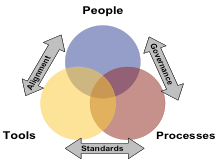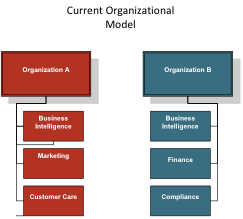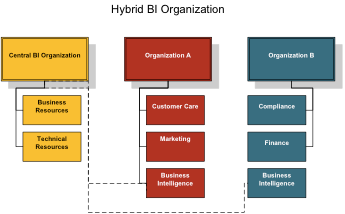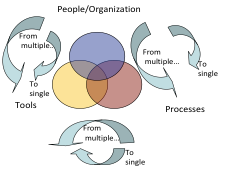We’re ready to get started, are you?
Get in touch and we can connect you with the right people.

Business Intelligence (BI) is often used as a shorthand term for data query and reporting. A search of the term would typically reveal a variety of information technology options, all referring to a ‘business intelligence solution’ meaning some combination of hardware and software. While technology is an integral part of BI, at least as important to its successful implementation is the organization and processes put in place to make the technology effective in meeting the business needs of the organization.
BI applications, organizations, and processes must do more than just support and enable traditional static reporting. The true purpose of BI is expanding the organization’s knowledge of itself and the environment it inhabits, and equally as important, making that knowledge readily accessible and understandable to the people responsible for operating the business. In fact,
“It’s not just about building a data warehouse and putting some reporting tools on top of it. It’s about putting a much larger framework together that includes a much larger piece of the organization, and delivering … different kinds of analysis capabilities than you’ve had in the past.”
(Bill Hostmann, Research Vice President, Gartner Inc, Gartner Business Intelligence Summit 2007, Redefining BI, ‘Searchbusinessanalytics.com, March 13, 2007).
There has to be an objective of balancing the technical focus (BI tools and infrastructure) with other considerations. Organization structure (a dimension of ‘people’) and alignment and process issues such as BI governance and policy and data management are not always considered. Incorporating and aligning these facets (see figure 1 below) can ensure the BI environment is able to achieve its ultimate goal.

Figure 1: Aligning People Processes and Tools
Financial Services companies have complex BI needs. From performance management to investment analysis, product mix and regulatory compliance reporting, Business Intelligence in financial institutions serves a wide range of constituents and meets a wide range of business needs.
An instructive example of BI adoption can be seen in one such firm, a business unit of a major financial institution. This organization has a decentralized leadership and operational model to ensure that the respective organizations responsible for such areas as servicing loans, managing the loan portfolio, and managing credit risk were highly responsive to the marketplace. The various organizations, referred to as business units, cooperated with one another but each were encouraged to act rapidly to meet business needs, resulting in their acting independently as well.
The firm used multiple data stores that had spawned hundreds of data marts to provide for management information needs. BI processes operated in an environment with these multiple data “marts” managed by different business units (BU’s) running on a variety of hardware platforms using different software. Concerns about data consistency surfaced in light of the duplicative processes inherent in the existing business operations. For example, there were at least three different customer identifiers being used across the BI platforms.
The platforms had primarily been built to support a particular business unit. Specific needs had evolved, based on each BU’s focus, while at the same time there was a need to have a picture of the total customer relationship. Most of the platforms contained some duplication of the data in other platforms but each mart had a specific focus, with more detail about some specific subject areas than the other marts.
Recognizing the challenge created by multiple data stores and sources, the organization embarked on a multi-year project to consolidate the many sources into a single companywide data warehouse. Recognizing the potential implications of moving from many specialized data sources to a few consolidated ones, key leaders of the business wanted to consider the implications to the firm’s utilization of the data – its BI capability.
Each business unit was responsible for its own BI. This could range from a rudimentary ‘what happened’ spreadsheet-based reporting capability, to highly productionalized automated reporting or analytics on a variety of BU applications. The corporate information technology organization was engaged in BI activities to varying degrees by each unit. Some business units used BI applications supported by IT; others supported their own applications. There was no single organization within the firm responsible for provision or oversight of Business Intelligence.
The organization realized that an opportunity existed to consolidate its many data sources and provide the business units with a single view of the data to improve its usefulness. As part of this effort, the company decided to work with HARKEN DATA to perform a business intelligence roadmap assessment and develop a plan for increasing the effectiveness of the BI process within the firm.
Though the roles and capability of each BI group varied based on the needs of the BU they supported, they were responsible at some level for the following activities for their business unit:
Extensive investigation and data gathering led to the following issue areas related to the organizations overall BI capability:
In conclusion, the organization lacked BI governance, tools, and processes that could be applied consistently across the enterprise. The de-centralized organizational model, which enabled the organization to respond quickly and effectively to the marketplace, also resulted in largely independent BI organizations. This contributed to duplicate costs, infrastructure, and data. The organization lacked a single ‘version of the truth’ that could be applied consistently throughout the business.
The organization enlisted the assistance of a BI consulting firm to gather the necessary data and develop a BI roadmap. The distributed nature of the organization and the diversity of the approaches in use made it necessary to gather data from a wide range of sources.
The BI partner elected to perform interviews with representatives of every major independent BI organization as well as the single information technology and central program management organizations. Twenty-seven individuals from ten business units were interviewed. In order to ensure a consistent evaluation, the interviews were built around a standard set of questions that the interviewers worked from. The questions were designed to glean data from the following BI subject areas:
This interview process was coupled with a comparison of processes within the ten business units to a study of BI best practices to create the following series of recommendations.
BI Roadmap Conclusions The course of action recommended by the BI roadmap assessment was as follows:
Adopt a best practice organizational model. Organizational design is a critical part of establishing an effective BI capability, but there is not a standard BI organization chart that would be effective in every organization. In this company, the distribution of BI resources throughout the business units (depicted in figure 2 below) resulted in multiple approaches to delivering BI to users. This in turn drove duplication of resources, processes, tools, and data, and made a single view of the business more difficult.

Figure 2: Current Organization Model
The organization of BI was consistent with the firm’s entrepreneurial operating model focused on business units independently responding to the marketplace, with BI attached to each. The data gathered in the Roadmap led the participants to conclude that the involvement and support of senior leadership in defining a BI strategy was important.
The first recommendation overall was to establish a BI Executive Steering Committee, composed of senior-level representatives from Business Units, IT, and the proposed central BI group. The purpose of this committee would be to set standards for a more standard BI organization and to place an executive imprimatur both on the concept of central BI, and the steps being taken to achieve it.
A common approach to unifying BI across an organization is the Business Intelligence Competency Center, or BICC. The prototypical BICC is an organization composed of both business and technical subject matter experts focused solely on delivering BI capability to the organization.
Due to the culture and emphasis placed on entrepreneurial speed, moving all BI resources into a single organization was thought to be a poor fit culturally in this case. The challenge then became to find a way to establish a BICC-like organization that would be a catalyst for the creation of company-wide BI standards and yet fit well into the organization from a cultural perspective.
Therefore, a hybrid option (figure 3 below) was recommended. In this construct, while some BI resources could move under common leadership into a narrowly scoped BICC, a core of key BI experts and analysts would retain direct reporting relationships within each BU. This would allow the BU to continue to manage and prioritize its internal reporting and analysis needs. The BICC would be able to utilize its’ dotted-line reporting relationships with the BI experts within the BU to implement companywide standards, tools, and processes with the oversight of the Executive steering committee.

Figure 3: Hybrid BI Organization
Rationalize and consolidate BI reporting tools and processes. The current decentralized BU structure was an enabler to increasing the number of applications in service. Each organization was focused on its own needs; maintaining separate dedicated tools and data helped ensure that applications were focused on the needs of a specific organization. However, multiple BI applications contributed to the duplication of efforts across the organization. In order to ensure that BI applications were used to their maximum capability, the recommendation was made to perform a detailed review of tool usage and capabilities with an ultimate goal of reducing the number of BI tools in service.
Key to any plan to reduce the number of applications in use is an understanding of the outputs generated by that application. It was recommended that the organization perform a detailed report and data extract inventory to ensure no key analytic data was lost due to the elimination of an application. The inventory would identify areas of duplication and overlap and provide a sound rationale for deciding which tools were the best candidates for elimination. Figure 4 has an example format for an inventory worksheet.

Figure 4: Sample Inventory Sheet
A comprehensive inventory of recurring reports and extracts could provide significant insight not only to sources of duplication, but also to redundant, duplicative, or obsolete outputs. This sort of insight could significantly reduce cost and complexity. For example, if the reports and data extracts provided by one BI application were a complete or near-complete subset of the total reports and data extracts provided by another, then a strong case might be made for implementing the first, since its elimination would not result in the loss of any data.
Expand data governance, standard metadata and business rules. As noted previously, the company had begun a multi-year project to consolidate data sources into a company-wide data warehouse prior to the start of the roadmap analysis. This created an opportunity to establish governance around the company’s data, including the creation of standard metadata and business rules that govern standard data transformations such as calculation of standard metrics. It is difficult for such governance to exist in an organization with a diversity of data sources, applications, and organizations. As data marts consolidate, a standard governance approach could be implemented; it might include the establishment of data steward roles within each BU with responsibility for ensuring the accurate definition and use of data in the warehouse and semantic layer.
Re-engineer and Conform Processes. The existing BI structure with its standalone BI organizations had many duplicate processes governing prioritization of efforts, issue reporting, project funding, and the like. Implementing a BICC structure would be a necessary step to standardize processes. Paradoxically, without the organization change proposed above, process standardization would not be possible, nor could centralized resources be effective with multiple sets of processes in place. For example, if the BICC were responsible for completing a company-wide prioritized list of enhancements and instead of having one overall list, there were one list for each BU, it might prove very difficult to even identify the organization-wide priorities, much less complete them.
Successfully standardizing processes across the organization would be a critical initial step in establishing BI capability that spanned the entire organization as well as being a key factor in change management. For example, the implication of a single project request and prioritization process would have been that in addition to a single process, there was also a single prioritized list for the whole company instead of a list for every BU. In the context of the whole company, one BU’s top priority to-do may not make it to the top ten for the combined company, creating a change management opportunity for the BICC.
Establishment of service level agreements (SLA’s) between the BICC and the BU’s would be an important next step. Since the primary goal of the BU’s is to remain responsive to the marketplace, it would be critical for the central BI resources to prove they would not reduce the BU’s responsiveness. This step would call for the BICC to jointly establish SLA’s for any centrally operated and managed activities with the BU’s, and measure performance against the SLA’s.
Business Intelligence is more than just software. While the term has been adopted as shorthand for various technologies, it might more accurately be considered the ongoing process of a corporate entity learning more about itself, its performance, competitors, customers, and overall marketplace. In this definition, BI applications must merge seamlessly with organizations and processes to deliver Business Intelligence.
This case study illustrates the criticality of those three aspects interacting together effectively. The BI roadmap concluded that implementing an efficient business intelligence technology required organizational change; BI processes required both organization and technology to change, and both also benefited from the establishment of processes.

Figure 5:
The three dimensions interact as shown in figure 5 above; in order to simplify the organization, processes must also become simpler. In order for processes to become simpler, tools and organizations must simplify as well. Business Intelligence doesn’t have to be complex in order to add value to the business – in fact, a less complex business intelligence environment provides greater flexibility in managing the complexities of the business itself.
About the Author:
Shiva kumar is principal consultant in Finance Performance Management at HARKEN DATA. He has over 25 years experience in Business Intelligence, both as a practitioner and user of Business Intelligence tools and information in Fortune 500 corporations and as a consultant.
Get in touch and we can connect you with the right people.